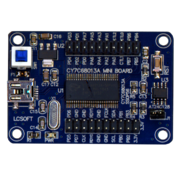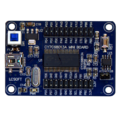Difference between revisions of "Lcsoft Mini Board"
| Line 62: | Line 62: | ||
=== Testing the firmware === | === Testing the firmware === | ||
2) Ensure you can access the USB device. One method is the following commands as root. A more elegant method is to use udev. See [[fx2lafw#Install_the_udev_rules_file]] for details. | 2) Ensure you can access the USB device. One method is to run the following commands as root. A more elegant method is to use udev. See [[fx2lafw#Install_the_udev_rules_file]] for details. | ||
3) Disconnect the EEPROM jumper. The chip will boot from its default bootloader. | 3) Disconnect the EEPROM jumper. The chip will boot from its default bootloader. | ||
Revision as of 11:11, 4 January 2013
 | |
| Status | supported |
|---|---|
| Source code | fx2lafw |
| Channels | 8/16 |
| Samplerate | 24MHz |
| Samplerate (state) | — |
| Triggers | none (SW-only) |
| Min/max voltage | ? |
| Memory | none |
| Compression | none |
| Website | lctech-inc.com |
The Lcsoft CY7C68013A Mini Board is a Cypress FX2(LP) eval board, which can be used as USB-based, 16-channel logic analyzer with up to 24MHz sampling rate.
It is a clone of the Saleae Logic.
In sigrok, we use the open-source fx2lafw firmware for this logic analyzer.
See Lcsoft Mini Board/Info for some more details (such as lsusb -vvv output) on the device.
Hardware
- Main chip: Cypress CY7C68013A-56PVXC (FX2LP)
- 3.3V voltage regulator: Advanced Monolithic Systems ASM1117-3.3
- 16kB I2C EEPROM: Atmel AT24C128A
- 24MHz crystal: JY24.0000601
All the pins on the FX2(LP) are broken out to 40 header pins. There's an on/off toggle switch, a reset button, and a jumper that lets you select whether the FX2LP gets its configuration from a small EEPROM, or boots into the default mode. The EEPROM's default settings make it come up with the same VID:PID as a Saleae Logic.
Photos
Protocol
Since we use the open-source fx2lafw firmware for this device, we don't need to know the protocol.
Flashing fx2lafw to the EEPROM
It is possible to flash fx2lafw directly to the EEPROM on the board. Flashing a firmware to ram and renumerating takes about two seconds. If fx2lafw boots from the EEPROM, this step is no longer necessary.
Prerequisites
- Linux environment
- fxload: your distribution may already package this. These instructions assume that you have fxload running.
- Second stage bootloader, Vend_Ax.hex
- sigrok-firmware-fx2lafw sources.
Building the firmware
To flash the firmware, you will need a hex file containing the firmware, fx2lafw-cypress-fx2.ihx. Since the hex file is a byproduct of the build, you will need to build the firmware from sigrok-firmware-fx2lafw sources.
1) Build and install fx2lafw. See fx2lafw#Build_fx2lafw for details.
Testing the firmware
2) Ensure you can access the USB device. One method is to run the following commands as root. A more elegant method is to use udev. See fx2lafw#Install_the_udev_rules_file for details.
3) Disconnect the EEPROM jumper. The chip will boot from its default bootloader.
4) Connect the board to the computer, and run a simple sigrok-cli test.
$ sigrok-cli --driver=fx2lafw --samples=8 -O bits -l 5
- If you a "fx2lafw: Device came back after [some] ms." the firmware works, and you can proceed.
- If however, you get a "fx2lafw: Device failed to renumerate." error, STOP. The firmware will not work.
Flashing the firmware
5) Disconnect the board from the PC, and connect the EEPROM jumper. The board needs to boot from the EEPROM, otherwise fxload will not be able to write to the EEPROM.
6) Look at lsusb for the bus and device address.
$ lsusb [...] Bus 009 Device 078: ID 0925:3881 Lakeview Research [...]
In this case, the bus is 009 and device is 078. You will need this information later.
7) Copy the hex file to your working directory. You will find it in sigrok-firmware-fx2lafw/hw/cypress-fx2/build/fx2lafw-cypress-fx2.ihx.
8) Copy the second stage bootloader downloaded earlier, in the working directory. The file is named Vend_Ax.hex.
9) Invoke fxload: fxload must be passed the usb device path via the -D parameter. This is usualy:
/dev/bus/usb/[bus]/[device]
or
/proc/bus/usb/[bus]/[device]
- The -I parameter specifies the hex file to be flashed, in our case fx2lafw-cypress-fx2.ihx.
- -s specifies the second stage bootloader. This is the program that gets loaded into FX2's RAM and handles the EEPROM flashing process.
- -t specifies the chip type. It will either be fc2 or fx2lp. In this case, I was using the fx2 (not fx2lp).
Invoke fxload. In my case, I needed to invoke as such:
$ fxload -D /dev/bus/usb/009/078 -I fx2lafw-cypress-fx2.ihx -c 0x01 -s Vend_Ax.hex -t fx2
10) DONE. Now you can disconnect the board from the computer. Leave the EEPROM jumper connected. The next time you connect the board, it will boot fx2lafw directly, and sigrok will not need to upload the firmware every time it runs.
Possible Issues
- With some kernel versions, and if the onboard EEPROM is disconnected (the jumper not connected) the kernel will automatically claim the device with a usbtest kernel module, seen in dmesg like usbtest 2-2:1.0: FX2 device — if this happens, sigrok will be unable to claim the device. Remove the usbtest kernel module as root to be able to use it:
$ sudo rmmod usbtest
You can add the usbtest module to a module blacklist permanently, at least in Debian-based distributions found in /etc/modprobe.d/blacklist.conf:
$ sudo sh -c "echo 'blacklist usbtest' >> /etc/modprobe.d/blacklist.conf"
Required Testing Hardware Extensions
Do not directly hook the board pins to another circuit, if you don't know what you are doing! This could damage the board!
The simplest circuit would be adding at least resistors in between your circuit-in-test and the Lcsoft board, but be aware here that the Cypress FX2(LP) chip can only tolerate a maximum of 5V I/O. Better would be to use a clamp circuit like shown at Spiralbrain's Blog (but you do not need to add another EEPROM for sigrok with fx2lafw!). A buffer circuit using a 74HC241 IC for protection is also possible. Check the fx2lafw page to see which protection circuits are used on other logic analyzer boards.
More information can be found in Circuits for barebone boards.





